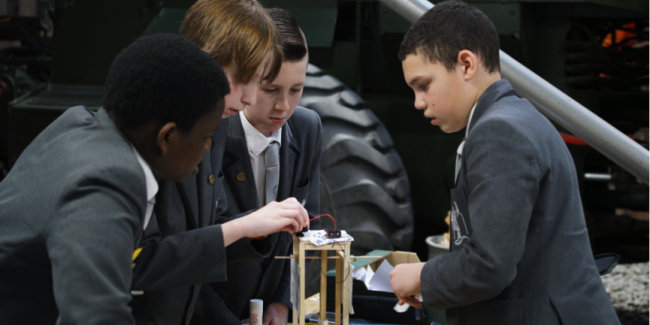
Interested in applying for Sixth Form at Holcombe Grammar School in September 2025?
To apply for a place at our Sixth Form for September 2025, please click here.

To apply for a place at our Sixth Form for September 2025, please click here.
Design Technology at Holcombe is focused on equipping students with a rounded experience of being a designer and maker. This experience is underpinned by traditional techniques but embraces the modern world of new technologies, innovative processes and materials.
Students are empowered to question the design world they live in and to find the problems of tomorrow. This iterative process demands originality, creativity and innovation. The department is passionate about design and producing designers equipped to excel in further education and in industry.

The department has gone through a re-design of all Key Stage 3 projects. This process had the goal of embracing the new departments team ethos and the new design technology specification of using design history to inform an iterative exploration of design ideas. Projects at Year 7 and 8 are based around fixed real life design scenarios. This program of study includes E-textiles, CAD and CAM design as well as graphic skills to creatively communicate design ideas. Year 9 students work with open briefs focusing on original outcomes and real world design scenario’s. This includes the design Ventura design museum competition, SMART materials and a preparing for university food project.
| Subject | Term 1 | Term 2 | Term 3 | Term 4 | Term 5 | Term 6 | |
|---|---|---|---|---|---|---|---|
| DT-Projects to be run on a rotation of 12 week projects so all projects will be active throughout the year. | Alessi Key fob Casting and Cutting Contextual research. Metal marking out. Cutting and shaping to tolerance. Finishing processes Metal Machinery Casting Metals | Alessi Key fob Casting and Cutting | Resistant Materials Arts and Crafts Tablet stand Wood and manufactured boards | Resistant Materials Arts and Craft Tablet stand | Graphics- Hand Held Design Science Museum pocket money game Drawing techniques Technical drawing Packaging and Nets Typography Vac-forming Presentation techniques | Graphics- Hand Held Design Science Museum pocket money game | |
| Subject | Term 1 | Term 2 | Term 3 | Term 4 | Term 5 | Term 6 | |
|---|---|---|---|---|---|---|---|
| DT-Projects to be run on a rotation of 12 week projects so all projects will be active throughout the year. | Mechanisms- Nation History Musuem Automata toy influenced by Ross Lovegrove. | Mechanisms- Nation History Musuem Automata toy influenced by Ross Lovegrove. | Resistant Materials-Alessi Metal key fob with vac-formed packaging. | Resistant Materials-Alessi Metal key fob with vac-formed packaging. | Graphics-Grand Designs CAD Architecture project. | Graphics-Grand Designs CAD Architecture project. | |
| Subject | Term 1 | Term 2 | Term 3 | Term 4 | Term 5 | Term 6 |
|---|---|---|---|---|---|---|
| DT-Projects to be run on a rotation of 12 week projects so all projects will be active throughout the year. | Design Ventura Museum competition. Real world design problems Market Research National Competition Iterative designing Working in design teams Rapid prototyping/CAD prototyping. Group Presentations | Design Ventura Museum competition | Dieter Rams inspired Lighting project -Electronic Systems Dieter Rams 10 principles of good design. Design icons (Focusing on the Anglepoise lamp) Modelling to tolerance Iterative designing Peer feedback Prototyping Soldering and electrics | Dieter Rams inspired Lighting project – Electronic Systems | Food- Preparing for university a survival guide for student living. Measuring out and preparing food Food nutrition Health and safety Raising agents Organoleptic qualities Conduction, Convection and Radiation | Food- Preparing for university a survival guide for student living. |
Please see attached the Key Stage 3 Learning Journey for Design Technology.
Students are taken on a truly creative journey where they develop their own design style. This includes entering the design museum competition to learning how to use the laser cutter, industry standard CAD/CAM programs and 3D printer. Students build a tool kit of workshop knowledge working in the traditional material groups and making processes. They also explore the latest SMART materials and manufacturing processes through completing a range of creative projects that leads to the non-examination assessment practice.
Students are offered a range of design contexts to explore leading to a personalised design brief. The design brief allows students to take their own creative journey to solve identified problems. It promotes a truly creative path of CAD modelling, rapid prototyping and iterative mix media designing. This leads to a unique outcome that is project managed to a fully operational prototype stage and is supported by precise technical drawings and a progressive evaluation leading to suitable improvements possibilities.
Design and Technology offers a unique opportunity in the curriculum for learners to identify and solve real problems by designing and making products or systems. Through studying GCSE Design and Technology, learners will be prepared to participate confidently and successfully in an increasingly technological world; and be aware of, and learn from, wider influences on design and technology, including historical, social/cultural, environmental and economic factors.
The subject content is presented under two headings: technical principles and designing and making principles. Within each area, the content is further divided into core knowledge and understanding and in-depth knowledge and understanding.
Learners will complete two components outlined below:
along with their ability to
A sustained design and make task, based on a contextual challenge set by the exam board, assessing candidates’ ability to:
| Term 1 | Term 2 | Term 3 | Term 4 | Term 5 | Term 6 |
|---|---|---|---|---|---|
| Timbers-Design and making principles | Electronics systems and Mechnical devices. | Smart, Modern, Composite and New Materials. | Design Museum Research trip. Iconic design project. | NEA Practice - Prototyping/Contexts | NEA year 11 Context release - Identifying and investigating design |
| Term 1 | Term 2 | Term 3 | Term 4 | Term 5 | Term 6 |
|---|---|---|---|---|---|
| NEA – Sketchbook Context Challenges Analysis Moodboards x3 Problems/Opportunities Designer Research Potential Users/Client Profile
| NEA - Portfolio & Making Existing Products Mini Brief/ Mini Specification Customer Profile/Customer interview Final Specification (Electronic) Final Design Brief (Circle Map) | NEA – Making Initial Design/ S.C.A.M.P.E.R Post-it Iteration Developed Designs/ Peer, Client Feedback Model Making x2 GANTT Chart/ QC | NEA Testing, Evaluation, Modifications Final Design Presentation Drawing CAD/ Finishes Material Testing Technical Drawing | Exam Revision Evaluation Feedback/Testing Improvements | GCSE Exams |
Please see attached Key Stage 3/4 Learning Journey for Design and Technology.
The Product Design A-level is a course designed to develop an interest into a passion. Students have the unique opportunity to develop their own design style and to experience a course tailored to preparing for the next step into University or into industry. The course teaches students how to be an all-round designer with them learning a tool kit of practical process, machinery, materials, CAD software and CAM processes. This allows the students to tailor their creative journey by being able to identify the correct processes and materials to solve the problems they set out in their own design briefs. The specification encourages learners to use creativity and to be confident to explore their own imagination.
| Term 1 | Term 2 | Term 3 | Term 4 | Term 5 | Term 6 |
| NEA – Intro to product design. EXAM – 1 – Innovation. Design movements Personal Mood board Multi flow maps Dieter Ramms | NEA – Context exploration. EXAM – 2 – Materials & Components Joints/Fixings and shaping materials Technical drawing Crating, Perspective, Isometric, Orthographic, Exploded. | NEA – Modelling & Testing. EXAM – 4 – Industrial & Commercial Practice Client profile/Moral, Social and Economic Thumbnails Problems/Opportunities Initial Designs Black/Brown paper and Biro | NEA – Modelling & Testing. EXAM – 5 – Product Analysis & Systems Incremental Post-its Sketch up CAD models Rapid Prototypes Peer Assessment | NEA – One Context. EXAM – 5&7 – Public Interaction & Marketing Design Brief proposals Mini Specifications Brief Analysis- Primary and Secondary | NEA – CAD Initial Design EXAM – Exam practice & review. Professional Tutorials SMART/Composite materials Ergonomics/Anthrometrics |
| Term 1 | Term 2 | Term 3 | Term 4 | Term 5 | Term 6 |
|---|---|---|---|---|---|
| NEA – Final Design. EXAM – 7 – Public Interaction & Marketing. Design Trip Designer Research Developed Designs/Tracing paper Reverse Engineering/Above and below the line Potential User/Questionnaire | NEA – Making. EXAM – 6 – Sustainability Specification Model making/testing CAD designs Full size/Scale modelling Alternative designing | NEA – Making. EXAM – 3 – Processes. Final Presentation drawing Detailed Designing x2 Existing Components/Materials Management Making commences OnShape CAD rendering Orthographic | NEA – Making Exploded drawing Risk Assessment GANTT chart Production plan/QC | Exam Practice Evaluation User Trials/Professional trials Improvements
| Exams |
Design and technology GCSE, Food preparation and nutrition and Product Design A level are gateway qualifications into a wide range of creative career paths. The courses provide students with the experiences to start to specialise in the area of the creative world they excel in. The courses also allow the learner to become a holistic designer with a wide range technical skills to allow for a widening of career possibilities.
Design Technology at Holcombe grammar school is focused on producing original designers, great makers but more importantly good citizens and cultivating future leaders. This starts by the department embracing open debate, team work and individualism. This iterative design journey is guided by proud and passionate staff that empower students to blossom in an environment of mutual respect and tolerance, with an ethos of originality over a path most trodden.
‘It’s better to fail in originality then to succeed in imitation’